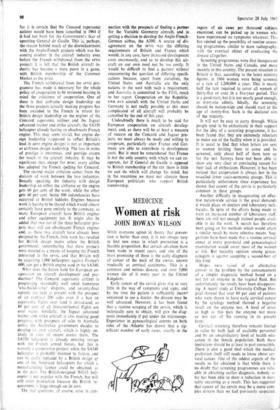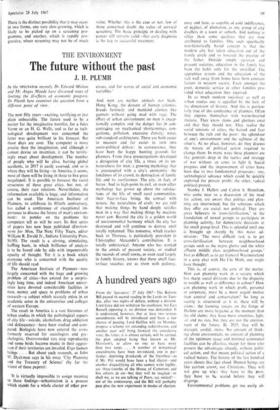Women at risk
MEDICINE JOHN ROWAN WILSON
While everyone agrees in theory that preven- tion is better than cure, it is not always easy to find new areas in which prevention is a feasible proposition. But certain advances have been made in recent years, and one of the most promising of these is the early diagnosis of cancer of the neck of the uterus, known medically as cervical carcinoma. This is a common and serious disease, and over 3,000 women die of it every year in the United Kingdom.
Early cancer of the cervix gives rise to very little in the way of symptoms and signs, and by the time the patient is sufficiently incon› venienced to see a doctor, the disease may be well advanced. However, it has been found that a routine scraping of the cervix, which is technically easy to obtain, will give the diag- nosis immediately if put under the microscope. Experience in gynaecological centres on both sides of the Atlantic has shown that a sig- nificant number of early cases, usually in the region of six cases per thousand subjects examined, can be picked up in women who have experienced no symptoms whatever. This has opentl up the possibility of routine screen- ing programmes, similar to mass radiography, with the eventual object of eradicating the disease altogether.
Screening programmes were first inaugurated in the United States and -Canada, and more recently in this country. The present situation in Britain is that, according to the latest ministry figures, in 1966 women were being screened at a rate of 1,200,000 a year. This is nearly half the rate required to cover all women of thirty-five or over in a five-year period. This is a good start, but it is not nearly good enough, as everyone admits. Ideally, the screening should be nation-wide and should start at the age of twenty-five. Such is the declared aim of the ministry.
It will not be easy to carry through. While people tend to be enthusiastic in their support for the idea of a screening programme, it has been found that they are extremely reluctant to make use of the facility when it is provided. It is usual to find that when letters are sent to women inviting them to come and. be screened, only about half of them turn up for the test. Surveys have not been able to show any very clear or convincing reason for their lack of enthusiasm. However, it has been noticed that cooperation is always less in the so-called lower socio-economic groups. This is particularly unfortunate since experience has shown that cancer of the cervix is particularly common in these groups.
Another difficulty in inaugurating an effec- tive nation-wide service is the great demands it would place on doctors and laboratory tech- nicians. In spite of the efforts being made to train an increased number of laboratory staff, there are still not enough trained people avail- able to do the work. A search has therefore been going on for methods which would attain a similar result by more selective means. Sug- gestions have been made that a routine cervical smear at every post-natal and gynaecological examination would cover most of the women at risk. But majority opinion among gynae- cologists is against accepting a second-best of this kind.
Hopes were raised of an alternative answer to the problem by the announcement of a simpler diagnostic method based on a test for an enzyme in the vaginal fluid. But unfortunately the results have been disappoint- ing. A recent study at University College Hos- pital showed that over 60 per cent of patients who were shown to have early cervical cancer by the cytology method showed a negative result on the enzyme test. A level of error as high as this puts the enzyme test more or less out of the running in its present form.
Cervical screening therefore remains limited in value by both lack of available personnel and by an unsatisfactory level of health edu- cation in the female population. Both these limitations should be at least in part correctible. There is also a good deal which the medical profession itself still needs to know about cer- vical cancer. One of the oddest aspects of the results so far obtained is that while there is no doubt that screening programmes are valu- able in obtaining earlier diagnosis, nobody so far has been able to show a reduction in mor- tality occurring as a result. This has ,suggested that cancer of the cervix may be a more com- plex disease than we had previously suspected.
There is the distinct possibility that it may occur in two forms, one very slow-growing, which is likely to be picked up on a screening pro- gramme, and another, which is rapidly pro- gressive, where screening may not be of much value. Whether this is the case or not, few of those concerned doubt the value of cervical screening. The basic principle in dealing with cancer still remains valid—that early diagnosis is the key to successful treatment.































 Previous page
Previous page